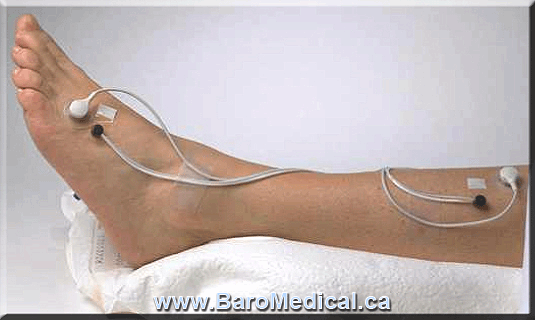Microcirculation Assessment
 Microcirculation refers to the network of capillaries, the smallest of the blood vessels, which are found in all parts of the body and are the site for gas and nutrient exchange between the blood and the tissues.
Microcirculation refers to the network of capillaries, the smallest of the blood vessels, which are found in all parts of the body and are the site for gas and nutrient exchange between the blood and the tissues.
Oxygen therapy works by first improving the microcirculation and cell metabolism; this will then lead directly to improvements in organ function. There is a direct relationship between the level of tissue oxygen tension and wound healing.
Microvascular Assessment
Transcutaneous tissue oximetry and laser doppler flowmetry are used together to assess the functioning of the microcirculation in a MicroVascular Assessment. This is a non-invasive, painless procedure, and a very important tool; it’s used for initial assessments (prior to starting hyperbaric oxygen therapy) as well as for monitoring the progress and success of hyperbaric oxygen therapy. The results of the initial assessment will tell us whether hyperbaric oxygenation is likely to be effective, and provides a precise estimate of many sessions will be needed.
Transcutaneous tissue oximetry and laser doppler flowmetry are well understood, widely accepted and validated procedures. When justifying the reimbursement of hyperbaric oxygen therapy the insurance agencies (in the USA) require microvascular assessment reports. At BaroMedical, we perform complete microvascular assessments and are Canadian leaders in the use of this technology.
Further reading:
- Ratzenhofer-Komenda B, Kovac H, Smolle-Jüttner FM, Friehs GB, Schwarz G.: Quantification of the dermal vascular response to hyperbaric oxygen with laser-Doppler flowmetry.; Undersea Hyperb Med. 1998 Winter;25(4):223-7
- Stirban A, Lentrodt S, Nandrean S, Pop A, Tschoepe D, Scherbaum WA.:Functional changes in microcirculation during hyperbaric and normobaric oxygen therapy.; Undersea Hyperb Med. 2009 Sep-Oct;36(5):381-90.
- Rich K.: Transcutaneous oxygen measurements: implications for nursing.; J Vasc Nurs. 2001 Jun;19(2):55-9; quiz 60-1. Review.
- Kalani M, Jörneskog G, Naderi N, Lind F, Brismar K.: Hyperbaric oxygen (HBO) therapy in treatment of diabetic foot ulcers. Long-term follow-up.; J Diabetes Complications. 2002 Mar-Apr;16(2):153-8.
- Stirban A, Lentrodt S, Nandrean S, Pop A, Tschoepe D, Scherbaum WA.:Functional changes in microcirculation during hyperbaric and normobaric oxygen therapy.; Undersea Hyperb Med. 2009 Sep-Oct;36(5):381-90.
- Svalestad J, Hellem S, Vaagbø G, Irgens A, Thorsen E.: Reproducibility of transcutaneous oximetry and laser Doppler flowmetry in facial skin and gingival tissue.; Microvasc Res. 2010 Jan;79(1):29-33. Epub 2009 Oct 23.
- Buras JA, Reenstra WR.: Endothelial-neutrophil interactions during ischemia and reperfusion injury: basic mechanisms of hyperbaric oxygen.; Neurol Res. 2007 Mar;29(2):127-31. Review.
- Gottrup F.: Oxygen in wound healing and infection.; World J Surg. 2004 Mar;28(3):312-5. Epub 2004 Feb 17. Review.
- Gottrup F.: Oxygen, wound healing and the development of infection. Present status.; Eur J Surg. 2002;168(5):260-3. Review.
- Kwiecinski MG.: Therapeutic value of hyperbaric oxygen in lower extremity ulcerations.; J Foot Surg. 1987 Sep-Oct;26(5):394-6.
- Hunt TK, Niinikoski J, Zederfeldt B.: Role of oxygen in repair processes.; Acta Chir Scand. 1972;138(2):109-10.
- Haddad HM, Leopold IH.: Effect of hyperbaric oxygenation on microcirculation: use in therapy of retinal vascular disorders.; Invest Ophthalmol. 1965 Dec;4(6):1141-51. Review.
- Löndahl M, Katzman P, Hammarlund C, Nilsson A, Landin-Olsson M.: Relationship between ulcer healing after hyperbaric oxygen therapy and transcutaneous oximetry, toe blood pressure and ankle-brachial index in patients with diabetes and chronic foot ulcers. ; Diabetologia. 2011 Jan;54(1):65-8. Epub 2010 Oct 19
